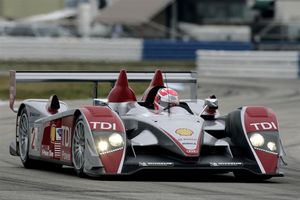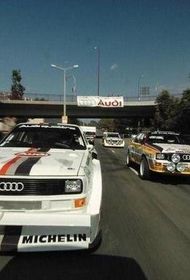.
Audi R10 LMP

| |
| Audi R10 | |
|---|---|
| Audi | |
| aka | |
| Production | |
| Class | |
| Body Style | |
| Length | |
| Width | |
| Height | |
| Wheelbase | |
| Weight | |
| Transmission | |
| Engine | |
| Power | |
| Similar | |
| Designer | |
The Audi R10 is a racing car prepared for sports car racing in the LMP1 class of the 24 Hours of Le Mans and other similar endurance races. The car was unveiled Tuesday, December 13 2005 at 12:00 CET, and went on to win both its maiden race at the 2006 12 Hours of Sebring and the 2006 24 Hours of Le Mans. It was the first diesel to win either of those events. The Audi R10 project costs Audi €70 Million per year.<ref>Sport Auto (German car magazine), ISSN 1158-2111, April 2006 issue</ref> This is the most ambitious and the most expensive project ever undertaken by Audi Motorsport.
Chassis
It supersedes the previous Audi R8, a proven model which won five times at Le Mans since 2000 while earning a reputation as one of the most successful racing cars of all time. In later years the ACO, who sets the rules for racing in the Le Mans 24 Hours, has reduced the restrictor size on the engine, and stipulated the R8 carry ballast, to make the races more competitive. In response to the new level of competition the development of a successor was necessary.
Though it bears a strong resemblance to the previous model, it is nevertheless a new design. The aerodynamic package is in compliance with the new regulations. A second rollover cage is added and the wheelbase is lengthened to accept the new, longer V12 TDI engine.
At the beginning of the 2006 season, homologation rules for LMP cars were changed, for the LMP1 class, an increase in minimum weight from 900 kg to 925 kg was mandated. While officially, this is to allow closed top prototypes to run with air-conditioning (as this would have added weight over open tops cars), some have speculated that this done at the behest of Audi to allow the R10 to be competitive.<ref>Mulsanne's Corner News, 12.12.05, Michael J. Fuller</ref> The R10 itself, as it ran during the 2006 12 Hours of Sebring was overweight at 935 kg, meaning that the engineers did not have the ability to play around with the weight ballasts (which would have been used to bring the car up to minimum weight if it were lighter than 925kg) to affect handling and balance.<ref>Mulsanne's Corner News, 3.25.06, Michael J. Fuller</ref>
Engine
The main novelty of the R10 is its engine: a TDI turbodiesel engine, running on Shell V-Power Diesel. It is a 5.5 L (335.6 ci) all-aluminium bi-turbo 90° V12, with common rail direct injection of more than 1600 bar (23,206 psi). Its output should be 650 hp (485 kW) (regulated) and 1100 N·m (811 ft·lbf) of torque, and its usable power band is between 3000 and 5000 rpm. Its benefits are a broad range of usable power, high torque and economy. Two Garrett turbochargers limited by the regulations to 2.94 bar (42.64 psi) absolute breathe through two 39.9 mm intake air restrictors. It uses the latest Bosch Motronic (MS14) management, provided by Bosch Motorsport, 1600 bar piezo injectors, and makes a low noise for a race car.
It will be difficult for Audi to overcome the weight of this engine. The latest Audi TDI 3.0 L V6 (183 ci) weighs 220 kg (485 lb) and the 4.2 L V8 255 kg (256.2 ci, 562 lb) but their blocks are made of CGI iron. The V12 is rumoured to weigh upwards of 200 kg,<ref>2006 Audi R10, Michael J. Fuller, Mulsanne's Corner, 2006</ref> Audi engineers admit that the weight per cylinder is the same as the precededing 3.6-litre FSI V8 of the Audi R8.<ref>Racing Toward Relevance, Christopher A. Sawyer, Automotive Design & Production, May 2006</ref> The wheelbase has been increased over the R8 to 2980 mm to account for this. This is unfavorable against the 130 kg (287 lb) of a concurrent Judd V10, and even the 180 kg of the Ricardo turbodiesel prototype based on it.<ref>Ricardo-Judd Diesel V10, Mulsanne's Corner, 2003</ref>
Audi's decision to use a diesel engine emphasizes the commercial success of TDI (and its competitors) on Europe's roads. It isn't however, the first diesel to be raced at Le Mans. In 2004 a Lola equipped with a Caterpillar re-badged VW V10 TDI ran for a few hours before breaking its gearbox. The first diesel-engined car to qualify and race at the 24 h race at Le Mans was a French entry in 1949, the first race held after the war. The car was the Delettrez Diesel entered by brothers Jean and Jacques Delettrez and was a 4395 cc 6-cylinder. It did not finish, running out of fuel about half way into the race. Delettrez entered again in 1950, as did another diesel car, the MAP. Again both cars DNF with engine problems, a cooling system leak in the case of the MAP. The MAP was interesting in that it was the first mid-engined car to race at Le Mans, the engine was located immediately behind the driver, and was a two-cylinder opposed piston two-stroke with rocking levers connected to a single crank, similar to the later Commer TS3 engine. Peugeot will compete with its new diesel effort in 2007 in its 908
Diesels in Racing
Diesels have made their mark in other forms of racing as well, as their superior torque and fuel economy can prove advantageous, while in turn, the higher weight and low revs of the engine is a disadvantage, requiring new power drive systems, too. Also, the rules have to accommodate the need for a high capacity engine with a turbocharger and high boost, something which is strictly regulated or no longer allowed for gasoline engines, as these had developed over 1000 hp in several race series of the past.
As early as 1931, Dave Evans, piloting the Cummins Diesel Special, became the first driver to complete the Indianapolis 500 without making a single pit stop. Evans completed the full distance on the lead lap and finished 13th. When Diesel technology made progess in the 1990s and rule makers supported the concept, BMW and Volkswagen raced diesel touring cars, with BMW winning the 1998 24 Hours Nürburgring mainly by being able to drive very long turns. In 2006, a BMW 120d repeated a similar result, scoring 5th in a field of 220 cars, many of them much more powerful, a significantly stronger competition than in 1998. Peugeot will follow Audi and develop a diesel powered endurance car for 2007: the Peugeot 908. The 908 will be more powerful and have more torque than the R10.
The Volkswagen Group itself uses a specially equipped diesel race Volkswagen Touareg at the Paris Dakar Rally, trying to score the first overall victory for a Diesel there.
Results
On 18 March 2007 the R10 won the 55th annual 12 Hours of Sebring making it Audi's 8th consecutive win.
On 18 March 2006, the #2 Audi R10 won the 54th annual 12 Hours of Sebring after earning pole position by setting a qualifying record. The #1 car did not finish due to an overheating problem.
On 18 June 2006, the #8 Audi R10 placed first at the 24 Hours of Le Mans, completing 380 laps, more than the R8 did, but less than the record set in 1967. The #7 Audi R10, which set fastest lap times in practice and race, came in third after suffering engine and turbo issues, completing 367 laps. At one point, the Joest team changed the #8 car's gearbox in under ten minutes, <ref>Audi’s new diesel-powered R10 dominates Le Mans, Gary Watkins, AutoWeek, 06/19/06</ref> compared to the hour and a half the fifth-place Pescarolo-Judd spent in the garage for similar repairs.
On 30 September 2006, the #2 Audi R10 won the 9th annual Petit Le Mans endurance race in Road Atlanta, Georgia. The win was seventh in a row for Audi in Petit Le Mans, but first for the R10 model. The #1 car was not running at the finish due to late race collision with another car resulting in damaged front suspension. #1 car was still classified in seventh place overall.
References
- Official Audi R10 Page, with the 13 December Paris presentation in video
- Official press release via AudiWorld.com, Tuesday, 13 December 2005, with more images
- Mulsanne's Corner: 2006 Audi R10, technical details focusing primarily on aerodynamics
- Auto Week: Making History, report on the 2006 Le Mans 24 Hour Race 19 June 2006
<references />

